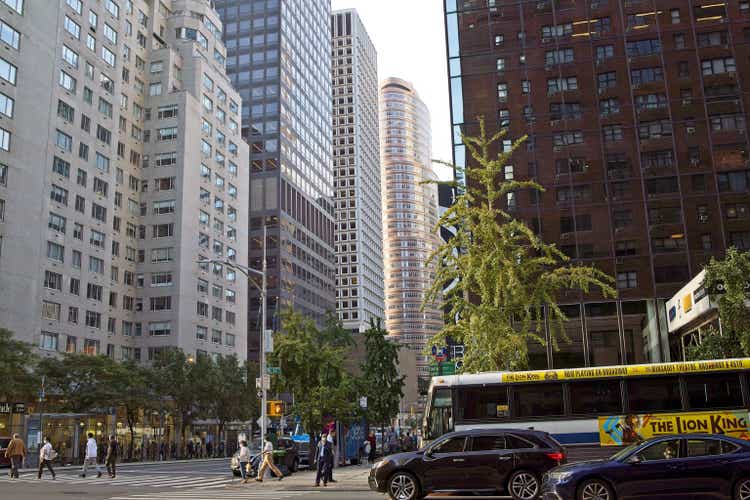Warren Eisenberg/iStock Editorial via Getty Images
These are challenging days in the office segment of commercial real estate (or CRE), as an economic slowdown threatens weaker employee headcounts and space demand in 2023, work-from-home remains difficult to predict over the next few years, and rising rates are squeezing liquidity and expected project returns.
SL Green (NYSE:SLG) is a high-quality option in the office REIT space, and I think high-quality names are good ones to own in tougher times, but I’m cautious for now. The shares do trade at what appears to be a large discount to net asset value (or NAV), but I do see risk to NAV estimates over the next six to 18 months and the combination of elevated leverage (and interest costs) and weaker net operating income (or NOI) could pressure the payout in the short term. There will be a good time to buy SLG again, but I don’t think this one is a must-buy right now unless you have a meaningfully more bullish outlook for the economy in 2023.
SL Green Realty Is Meeting Expectations For Q3, But The Details Are More Mixed
SL Green met Street expectations for funds from operation (or FFO) in the third quarter, but I would argue that the quality of the beat did leave something to be desired. Core NOI missed by around $0.09/share, and interest expense was also worse than expected. Offsetting this was better DPE, operating expenses, and “other” items.
Higher interest expense isn’t so surprising given the environment, but investors may take issue with the role that fees and unaccrued income played in meeting the expected FFO/share number. Likewise, with the DPE book balance falling to $664M, some analysts may need to revise their ’23 estimates lower.
Cash same-store NOI was down 0.5% in the quarter, not only a significant deceleration from the prior quarter (up 6.7% yoy), but also weaker than expected. Manhattan office occupancy and same-store leased occupancy were both basically flattish from the prior quarter in the low 90%’s (91.4% and 92.1%, respectively), and cash leasing spreads improved by 2.8%.
A Challenging Environment For A Proven Player
SL Green has long maintained a high-quality portfolio of A-grade Manhattan office properties, but quality can only offset a challenging macro picture just so far.
Manhattan office occupancy rates are around 15% now, the highest since the mid-1990’s, and with business confidence getting weaker and growing concerns about a recession in 2023, the outlook for employment, space demand, and leasing spreads isn’t so great at the moment. At the same time, rising interest rates will pressure the balance sheet and income statement (as seen with the higher interest expense this quarter) and reduce expected project returns.
As far as positive drivers go, there isn’t all that much new space coming into the market in the near term. It’s also plausible that a weaker job market could give employers more leverage to shift more of their workforce back to in-office work, though this driver/trend is complex and difficult to model (some employers may well value the reduced need for office space that work-from-home supports).
I’d also note some company-specific positives in SL Green’s favor. The company’s high-grade portfolio should serve it well, as A-class office space typically holds up better during challenging market periods, and SL Green has a manageable and below-average level of lease expirations over the next two years. I also see the company’s evolution of its business model as a longer-term positive.
The Outlook
I believe a double-digit decline in adjusted FFO is possible next year, which would represent still-significant downside risk to sell-side estimates from here, but I also believe the downturn will be relatively brief and that 2024 could see a solid rebound, possibly reaching the double-digits. Long term, I don’t see why SL Green couldn’t grow AFFO at an average rate in the neighborhood of 3% to 4%, and that can support a fair value comfortably in the mid-$40’s now. It’s important to note that a discounted AFFO model depends significantly on discount rates, and a modest change in the rate can drive a significant swing in the fair value.
It’s not uncommon to value REITs like SL Green on the basis of a multiple to 12-month FFO or AFFO and/or a discount to NAV. While these are easier approaches in some respects (there’s more modeling risk the further out you go), those multiples/discount rates are highly sensitive to sentiment, and I’m not as fond of using them as some investors are. I will note, though, that while SL Green shares appear to be trading at an historically wide discount to NAV (close to 50% of sell-side NAV estimates), I think NAV estimates may well be inflated. With that, I do think the NAV discount is wider than normal now, but not as wide as it may first appear (maybe closer to 35% versus a historical average closer to 20%).
The Bottom Line
I do think that SL Green is undervalued, but I also see ongoing risk to sentiment and estimates for at least the next six to 12 months. With that, the long-term return from buying today may well be attractive, but investors have to recognize the risk of further weakness in the interim. This is a name that I intend to revisit next year, but for now I think the conditions in the office REIT space make this a difficult one to recommend despite a discount to fair value.


Be the first to comment